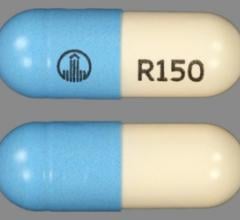
The Medtronic Linq II implantable cardiac monitor.
September 8, 2021 — Continuous heart rhythm monitoring – with anticoagulation if atrial fibrillation is detected – does not prevent strokes in those at risk. That was the finding of late breaking LOOP Study presented in a Hot Line session today at European Society of Cardiology (ESC) Congress 20211 and published in the Lancet.[1]
Atrial fibrillation is the most common heart rhythm disorder, affecting more than 33 million people worldwide.[2] The disorder increases the risk of stroke by five-fold, but this risk can be reduced with anticoagulation treatment.[3] The LOOP study was initiated because patients with atrial fibrillation are often asymptomatic and thus remain undiagnosed and untreated.
The study investigated whether continuous electrocardiogram (ECG) monitoring using an implantable loop recorder, and subsequent anticoagulation if atrial fibrillation was detected, would reduce the risk of stroke or systemic arterial embolism in patients at risk.
“In a population of high-risk patients, atrial fibrillation was detected and treated much more often in those undergoing ECG monitoring. We found a non-significant 20% reduction in risk of stroke which was not accompanied by a similar reduction in cardiovascular mortality," explained principal investigator Professor Jesper Hastrup Svendsen of Copenhagen University Hospital - Rigshospitalet, Denmark. "More studies are needed but our findings may suggest that not all atrial fibrillation is worth screening for, and not all screen-detected atrial fibrillation merits anticoagulation.”
Danish national registries were used to identify individuals from the general population aged 70 years or older with at least one of the following additional stroke risk factors: hypertension, diabetes, heart failure or previous stroke. The exclusion criteria included any history of atrial fibrillation, currently using oral anticoagulation, a contraindication to oral anticoagulation, or a cardiac implantable electronic device (CIED).
Participants were randomized in a 1:3 ratio to receive continuous ECG monitoring or standard care. Those in the monitoring group had an implantable loop recorder (Medtronic Reveal Linq) inserted under the skin on the left side of the chest under local anesthesia. The device continuously (24/7) recorded the heart’s electrical activity. Every night, any ECGs indicating heart rhythm abnormalities (such as atrial fibrillation) were transferred remotely to a server for evaluation by clinicians. If atrial fibrillation lasting more than six minutes was diagnosed, patients were advised to start oral anticoagulation. The standard care group had a telephone consultation with a nurse once a year. The primary outcome was time to the combined endpoint of stroke or systemic arterial embolism.
A total of 6,004 participants were randomised: 1,501 to monitoring and 4,503 to standard care. The mean age was 74.7 years and 47.3% were women. The median duration of monitoring was 39.3 months, and the median follow-up period was 64.5 months.
Participants in the monitoring group were more likely to have atrial fibrillation detected and to start oral anticoagulation compared to those receiving standard care. Atrial fibrillation was diagnosed in 477 participants (31.8%) in the monitoring group and 550 (12.2%) in the control group (hazard ratio [HR] 3.17; 95% confidence interval [CI] 2.81–3.59; p<0.001). Oral anticoagulation was initiated in 445 participants (29.7%) in the monitoring group and 591 (13.1%) in the control group (HR 2.72; 95% CI 2.41–3.08; p<0.001).
The primary outcome occurred in 318 participants, including 67 (4.5%) in the monitoring group (0.88 events per 100 person-years; 95% CI 0.68–1.12) and 251 (5.6%) in the control group (1.09 events per 100 person-years; 95% CI 0.96–1.24). There was no significant difference between the two groups (HR 0.80; 95% CI 0.61–1.05; p=0.11).
Cardiovascular death occurred in 43 participants (2.9%) in the monitoring group versus 157 (3.5%) in the control group (HR 0.83; 95% CI 0.59–1.16; p=0.27), and death from any cause occurred in 168 participants (11.2%) in the monitoring group versus 507 (11.3%) in the control group (HR 1.00; 95% CI 0.84–1.19; p=1.00).
Funding for the LOOP Study is supported by The Innovation Fund Denmark [12-135225], The Research Foundation for the Capital Region of Denmark [no grant number], The Danish Heart Foundation [11-04-R83-A3363-22625], Aalborg University Talent Management Program [no grant number], Arvid Nilssons Fond [no grant number], Skibsreder Per Henriksen, R. og Hustrus Fond [no grant number], Læge Sophus Carl Emil Friis og hustru Olga Doris Friis’ Legat [no grant number], and an unrestricted grant from Medtronic [no grant number].
Professor Svendsen is a member of Medtronic advisory boards and has received speaker honoraria and research grants from Medtronic in relation to this work and outside this work.
Find more ESC Hot Line late-breaking study news
References:


 August 28, 2023
August 28, 2023 








